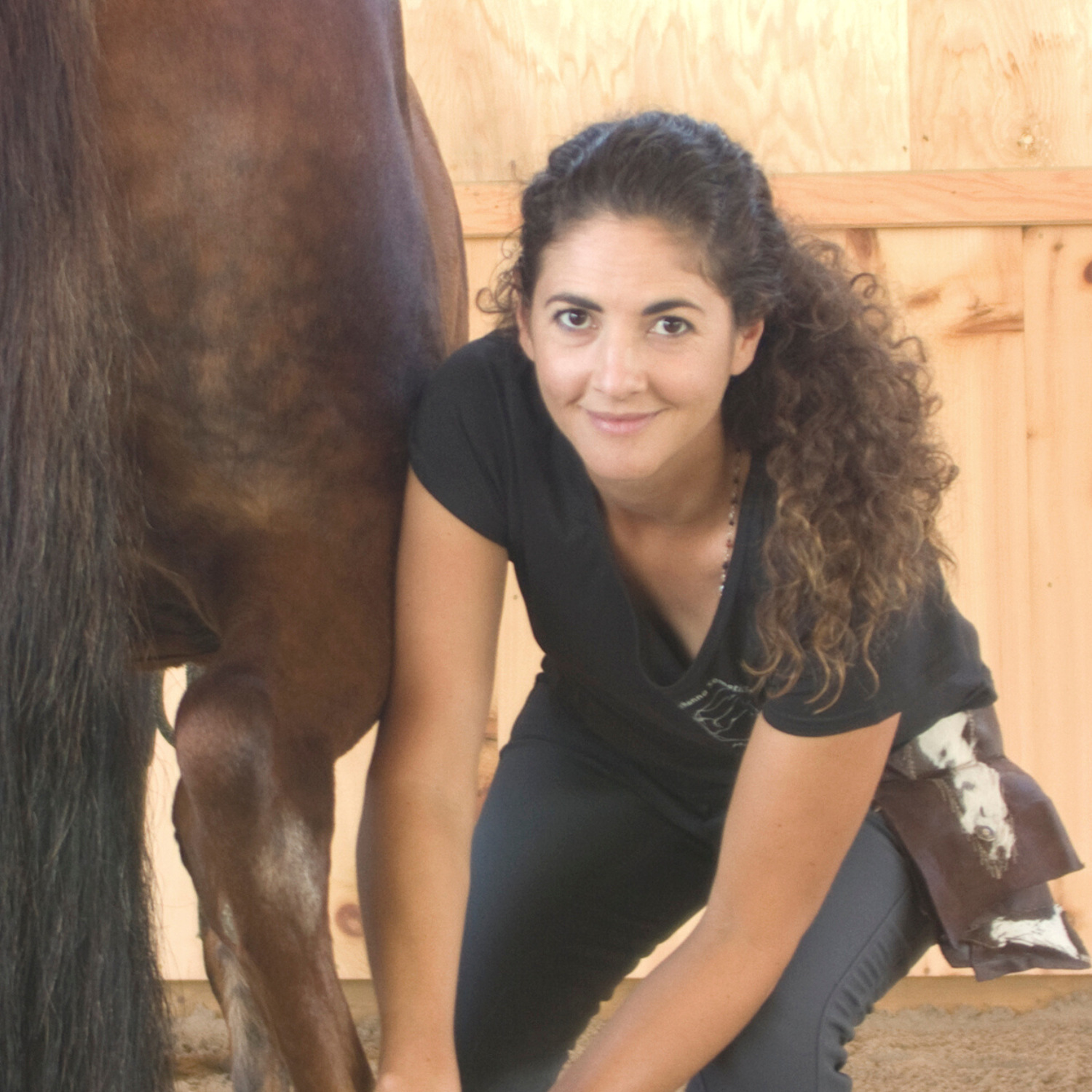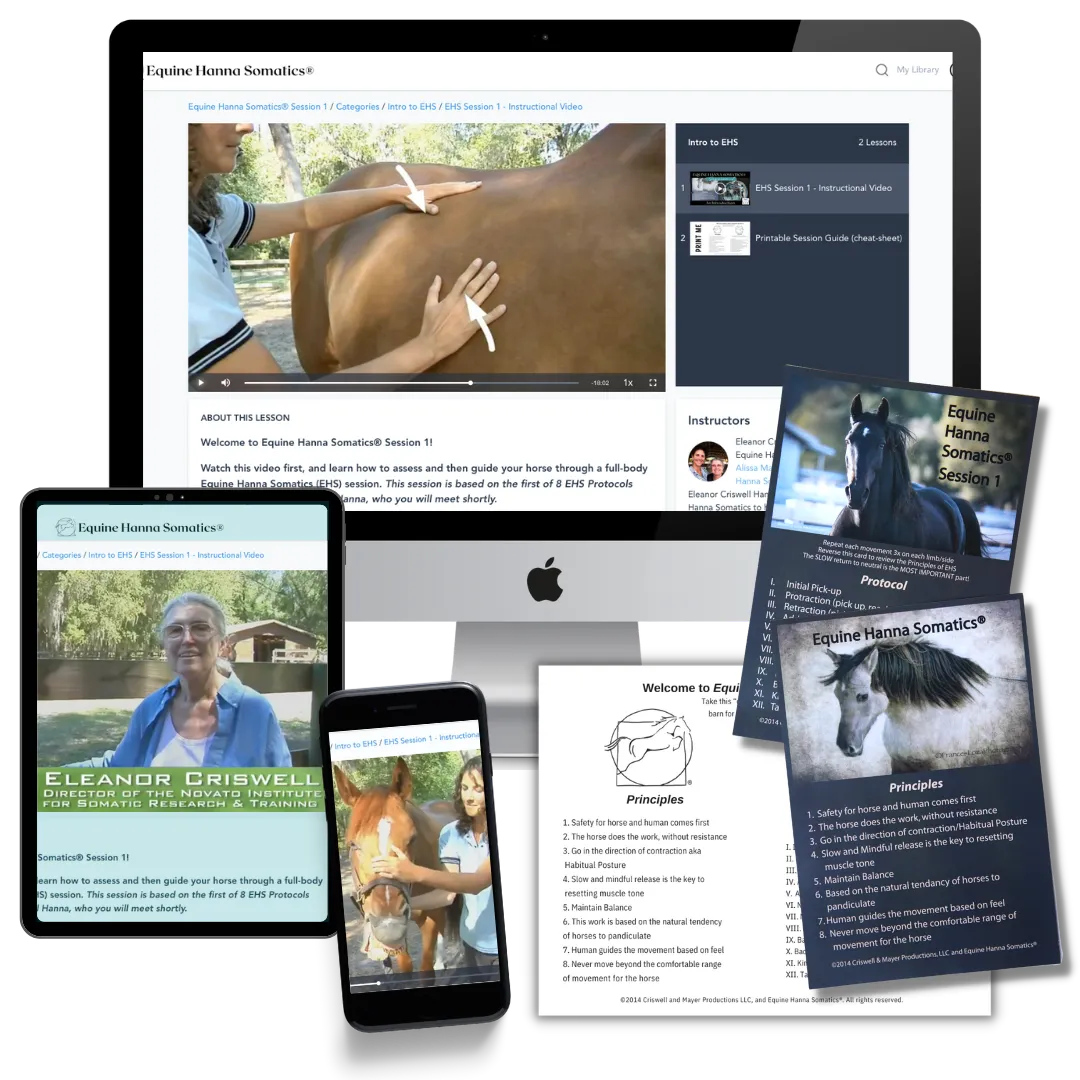Mindfulness in EHS vs. Seeking Response in R+
By Alissa Mayer BSc(Equine) EHSE-C in collaboration with Eleanor Criswell Ed.D
Like in R+ training, Equine Hanna Somatics® (EHS) provides positive reinforcement. But unlike in R+ training, this reinforcement is intrinsic to the somatic movement and the shared interaction with the person, an internal self-rewarding process, VS. the externally applied reinforcers or rewards used in R+.
There is also a distinct difference in the underlying motivations - EHS is natural and physiologically pleasing to the individual to do with their body, while R+ is aimed at the horse doing what the trainer considers pleasing.
The Physiology of Mindful Movement
As we guide a horse through the EHS exercises, they relax their contracted muscles, which feels good. The movements themselves stimulate all sorts of sensory receptors (like Ruffini corpuscles, etc.) that send pleasurable feedback up to the brain. There is also a sense of completion or satisfaction that comes from the corollary discharge associated with the movements - when the horse does what they intended to do with their body, when they succeed in doing what they planned to do, the sense of completion is a built-in self-rewarding experience.
Shared Nervous System
And like a human baby who has finally succeeded in doing something new with their body - like learning to curl their fingers into a fist to give a thumbs-up, or doing a high-five - the baby (or the horse) will joyfully repeat their new skill or success and want to show it to you over and over - because we are part of the experience. Research is showing that we are actually part of their nervous system, that we (the parent) are engaged in helping the babies regulate their own nervous systems. This is also likely true of our interactions with horses. Our internal state, our sense of pleasure at their actions and accomplishments, becomes part of their experience, and we are supporting their brain development and sense of completion from their self-directed activities. Simply by being there with them, sharing the experiences of allowing them to make choices, take actions and learn from the outcomes.
In EHS, we want the horses to be paying attention to and getting used to listening to their own somatic feedback from their behaviors (in the present session, and ideally in all future movements too). Using treats distracts them from doing this by shifting their focus from internal to external, from feeling and being to searching and seeking.
The Physiology of Searching & Seeking
This is because treats or food rewards immediately change the horses brain state. The limbic system gets very excited around the appetitive process (tasting/smelling, chewing, eating) and of course, wanting more. This effectively “changes the channel” in the brain and the horse will no longer be attentive to their somatic (sensory) feedback.
It takes time for the brain to switch back to the “somatic channel” and even once it does, most horses will repeatedly switch back to the “seeking/limbic system channel” throughout the session if a food reward was introduced previously. This is especially true if the horse has formed an association with humans reaching into a pocket with them getting a treat, for example. ;)
A treat or bridged reward (like a click) may also inadvertently invite and then reinforce a movement that bypasses the horses comfortable range of motion (like when reaching for a carrot) or that triggers the stretch reflex - two things we are actively avoiding when doing EHS.
Fast vs. Slow Movement
External motivation to give the handler what they want in exchange for a reward, in combination with the excitement of the Limbic System, often results in horses making quick movements, and/or offering a rapid-fire series of behaviors in the hope of doing the one that will earn the reward. These types of movements are not slow and mindful voluntary movements, which are what we are after with EHS, but are previously learned automatic movement patterns now performed ‘mindlessly’ by the horse. This is an important distinction to recognize, because it is the voluntary motor cortex - the area of the brain in charge of slow, deliberate movements - that can mediate muscle de-contractions (aka lengthening), whereas fast, smooth and automatic movements are under the control of the cerebellum - a completely different part of the brain that is not capable of changing resting muscle tonus like the voluntary motor cortex is.
Extrinsic vs. Intrinsic Reinforcement
When a horse gets a treat, food or click as a reward (an external or extrinsic reinforcer), the reward itself becomes the goal and the horse is motivated to do something for YOU to get the treat, rather than doing something for themselves, because it feels good (an internal or intrinsic reinforcer).
The Ultimate Goal of Equine Hanna Somatics
We are interested in supporting horses in becoming actualized, to become the most athletic, intelligent, present and happiest versions of themselves - and to do that, we need to work with them in partnership at every level.
One of the ways we can connect to horses on a nervous system level, is by recognizing that clicking and treating are external rewards, and that by not using them all the time, but by facilitating and joining the horses in the internal self-rewarding experience of an EHS session, our external can become their internal.
And then we can take this awareness, this shared feeling, this common nervous system approach, into all the other things we are doing with horses…




